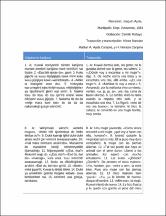Karijona Womirïko: La palabra de los carijona
[English below]
De origen Guayanés, los Carijona se separaron de los Tiriyó, sus parientes lingüísticos más cercanos, hace cerca de 8 siglos. Durante su larga travesía hasta los alrededores de la Sierra de Chiribiquete, prestaron léxico de fauna y flora Neengatú, una forma de ritual de Yuruparí y el personaje Kuwai de los Arawak, formas de parentesco dravídicas y uso del yajé de los Tucano oriental. Asentados sobre las riberas de los ríos Macaya, Ajaju, Mesay, Cuñaré y Yarí, se estima que poco antes de 1800 podían sumar 20 mil personas. Comerciaron por el este, el norte y el oeste, mientras hacia el sur invadieron territorio y batallaron con los grupos Uitoto, según los carijona, con grandes pérdidas para ellos, hasta que consiguieron un acuerdo con los Uitoto que quedó sellado por un ritual que los vencedores celebran y llaman “Baile de Carijona”. La economía del caucho, la extracción de resinas y pieles los sacó de su territorio tradicional. En la primera mitad del siglo XX, además de las luchas Inter tribales, en los campamentos de cauchería, en Miraflores, Calamar y La Pedrera el sarampión los diezmó, hasta quedar reducidos a unas pocas centenas, dispersas entre a los largo de los ríos Orteguaza, el bajo Caquetá y el alto Vaupés. En medio del auge de la producción y comercio de pasta de coca, en el Resguardo de Puerto Nare, a una hora de Miraflores (Guaviare) ocurrió la masacre paramilitar en 1982 que cobró la vida de varios sabedores y al último payé. Luego vino la fumigación de glifosato, que los Carijona demandaron y fueron declarados víctimas con derecho a reparación por la Corte Constitucional (Sentencia T-080de 2017). En Puerto Nare todavía saben la lengua, practican el dabucurí, y comienzan un proceso de revitalización del que los grupos del Orteguaza y de Puerto Córdoba están atentos.
La colección contiene 15 grabaciones, algunas con video y archivos pdf con la transcripción y traducción y con segmentación yuxtalineal en FLEX.
________________________
[en]
Guayanese in their origin, the Carijona people separated from the Tiriyó, their closest linguistic relatives, about 8 centuries ago. During their long journey to the the Sierra de Chiribiquete, they borrowed Neengatú fauna and flora lexicon, a form of Yuruparí ritual and the Kuwai character of the Arawak, Dravidian forms of kinship and the use of the yajé hallucinogenic of the eastern Tucano. Settled on the banks of the Macaya, Ajaju, Mesay, Cuñaré and Yarí rivers, before the 1800 it is estimated that there could be 20 thousand people. They traded to the east, north and west, while to the south they invaded territory and battled with the Uitoto groups, according to them with great losses, until reaching an agreement that was sealed by a ritual. The winners celebrate and call this ritual: “Baile de Carijona”. The rubber economy, the extraction of resins and skins took them out of their traditional territory. In the first half of the 20th century, in addition to the intertribal fights, in the rubber camps, in Miraflores, Calamar and La Pedrera the measles epidemic decimated them, until they were reduced to a few hundred, scattered along the Orteguaza, the lower Caquetá and the upper Vaupés rivers. During the boom in the production and trade of coca paste, in the Puerto Nare Reservation, one hour from Miraflores (Guaviare), a paramilitary massacre aimed Puerto Nare in 1982, it took the lives of several carijonas and their last payé. Then came the fumigation of glyphosate, which the Carijonas sued and were declared victims with the right to reparation by the Constitutional Court (Sentence T-080 of 2017). In Puerto Nare they still know the language, they practice Dabucurí ritual, and they are beginning a revitalization process that the groups from Orteguaza and Puerto Córdoba are interested to follow.
The collection contains 15 recordings, some with video and pdf files with transcription and translation and with juxtalinear segmentation in FLEX.
Envíos recientes
-
3. Ëkëimë werichimuguru marë

Los parientes salen de cacería y dejan a las dos hermanas haciendo chicha de casabe. Ellas estan enamoradas de un hombre muy apuesto, que llega, muy arreglado. Comienzan a bailar, y poco a poco van hacia la orilla del río. ... -
2. Jërërëresto (Arawatakabë)

Un hombre sale a cazar tapir. A su regreso, invita a su mujer a arreglar la presa pero es a ella a quien descuartiza y pone a ahumar. Lleva la carne a maloca de la familia de ella. Dice el marido que ella viene por el ... -
1. Kuwai

De un árbol de laurel Kuwai talla a la primera mujer. Entre él y los animales logran abrir su vagina. Ella es quien hace la bebida para las fiestas. El Rey Gallinazo la quiere pero Kuwai lo detiene y lo obliga a revelar ...






